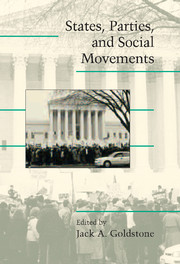Book contents
- Frontmatter
- Contents
- List of Figures and Tables
- Foreword
- Acknowledgments
- Contributors
- INTRODUCTION: BRIDGING INSTITUTIONALIZED AND NONINSTITUTIONALIZED POLITICS
- I States and Social Movements
- II Parties and Social Movements
- 5 PARTIES OUT OF MOVEMENTS: PARTY EMERGENCE IN POSTCOMMUNIST EASTERN EUROPE
- 6 FROM MOVEMENT TO PARTY TO GOVERNMENT: WHY SOCIAL POLICIES IN KERALA AND WEST BENGAL ARE SO DIFFERENT
- 7 PARTIES, MOVEMENTS, AND CONSTITUENCIES IN CATEGORIZING RACE: STATE-LEVEL OUTCOMES OF MULTIRACIAL CATEGORY LEGISLATION
- 8 PROTEST CYCLES AND PARTY POLITICS: THE EFFECTS OF ELITE ALLIES AND ANTAGONISTS ON STUDENT PROTEST IN THE UNITED STATES, 1930–1990
- Afterword: Agendas for Students of Social Movements
- References
- Index
7 - PARTIES, MOVEMENTS, AND CONSTITUENCIES IN CATEGORIZING RACE: STATE-LEVEL OUTCOMES OF MULTIRACIAL CATEGORY LEGISLATION
Published online by Cambridge University Press: 26 February 2010
- Frontmatter
- Contents
- List of Figures and Tables
- Foreword
- Acknowledgments
- Contributors
- INTRODUCTION: BRIDGING INSTITUTIONALIZED AND NONINSTITUTIONALIZED POLITICS
- I States and Social Movements
- II Parties and Social Movements
- 5 PARTIES OUT OF MOVEMENTS: PARTY EMERGENCE IN POSTCOMMUNIST EASTERN EUROPE
- 6 FROM MOVEMENT TO PARTY TO GOVERNMENT: WHY SOCIAL POLICIES IN KERALA AND WEST BENGAL ARE SO DIFFERENT
- 7 PARTIES, MOVEMENTS, AND CONSTITUENCIES IN CATEGORIZING RACE: STATE-LEVEL OUTCOMES OF MULTIRACIAL CATEGORY LEGISLATION
- 8 PROTEST CYCLES AND PARTY POLITICS: THE EFFECTS OF ELITE ALLIES AND ANTAGONISTS ON STUDENT PROTEST IN THE UNITED STATES, 1930–1990
- Afterword: Agendas for Students of Social Movements
- References
- Index
Summary
This essay tries to explain why so many state legislatures in the 1990s considered and in some cases adopted state laws that required the addition of a multiracial category on state documents such as school forms, employment applications, and birth and death certificates. Between 1992 and 1997, six states passed multiracial category laws, similar legislation was introduced in five other states, and two states added a multiracial classification by administrative mandate. This sudden explosion of state legislative activity is remarkable given that, as recently as 1967, sixteen U.S. states actively enforced anti-miscegenation laws. Less than thirty years later, almost as many states had considered some form of multiracial category legislation.
Grassroots activists provided the spark that initially ignited debates concerning the multiracial category. These activists challenged the logic of racial categories, arguing that the only pure thing about race is its social salience. The multiracial movement, which can be formally dated from 1988, is led by people who consider themselves to be multiracial or are in interracial relationships, often with young children. Its leaders have argued that it is both inaccurate and an affront to their identity to force them and/or their children into a “monoracial” box. Emphasizing the fact that the multiracial population is growing exponentially and that, in increasing numbers, millions of Americans are not identifying within the officially mandated categories, the multiracialists have argued a case that has increasingly gained attention and response from a wide array of elected officials.
- Type
- Chapter
- Information
- States, Parties, and Social Movements , pp. 197 - 225Publisher: Cambridge University PressPrint publication year: 2003



